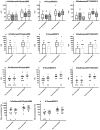Increased risk of influenza among vaccinated adults who are obese
- PMID: 28584297
- PMCID: PMC5585026
- DOI: 10.1038/ijo.2017.131
Increased risk of influenza among vaccinated adults who are obese
Abstract
Background: Influenza infects 5-15% of the global population each year, and obesity has been shown to be an independent risk factor for increased influenza-related complications including hospitalization and death. However, the risk of developing influenza or influenza-like illness (ILI) in a vaccinated obese adult population has not been addressed.
Objective: This study evaluated whether obesity was associated with increased risk of influenza and ILI among vaccinated adults.
Subjects and methods: During the 2013-2014 and 2014-2015 influenza seasons, we recruited 1042 subjects to a prospective observational study of trivalent inactivated influenza vaccine (IIV3) in adults. A total of 1022 subjects completed the study. Assessments of relative risk for laboratory confirmed influenza and ILI were determined based on body mass index. Seroconversion and seroprotection rates were determined using prevaccination and 26-35 days post vaccination serum samples. Recruitment criteria for this study were adults 18 years of age and older receiving the seasonal trivalent inactivated influenza vaccine (IIV3) for the years 2013-2014 and 2014-2015. Exclusion criteria were immunosuppressive diseases, use of immunomodulatory or immunosuppressive drugs, acute febrile illness, history of Guillain-Barre syndrome, use of theophylline preparations or use of warfarin.
Results: Among obese, 9.8% had either confirmed influenza or influenza-like-illness compared with 5.1% of healthy weight participants. Compared with vaccinated healthy weight, obese participants had double the risk of developing influenza or ILI (relative risk=2.01, 95% CI 1.12, 3.60, P=0.020). Seroconversion or seroprotection rates were not different between healthy weight and obese adults with influenza or ILI.
Conclusions: Despite robust serological responses, vaccinated obese adults are twice as likely to develop influenza and ILI compared with healthy weight adults. This finding challenges the current standard for correlates of protection, suggesting use of antibody titers to determine vaccine effectiveness in an obese population may provide misleading information.
Conflict of interest statement
The authors declare no conflicts of interest.
Figures

Similar articles
-
Efficacy of high-dose versus standard-dose influenza vaccine in older adults.N Engl J Med. 2014 Aug 14;371(7):635-45. doi: 10.1056/NEJMoa1315727. N Engl J Med. 2014. PMID: 25119609 Clinical Trial.
-
Effectiveness and cost-benefit of influenza vaccination of healthy working adults: A randomized controlled trial.JAMA. 2000 Oct 4;284(13):1655-63. doi: 10.1001/jama.284.13.1655. JAMA. 2000. PMID: 11015795 Clinical Trial.
-
Safety, immunogenicity, and lot-to-lot consistency of a quadrivalent inactivated influenza vaccine in children, adolescents, and adults: A randomized, controlled, phase III trial.Vaccine. 2015 May 15;33(21):2485-92. doi: 10.1016/j.vaccine.2015.03.065. Epub 2015 Apr 2. Vaccine. 2015. PMID: 25843270 Clinical Trial.
-
Obesity Impairs the Adaptive Immune Response to Influenza Virus.Ann Am Thorac Soc. 2017 Nov;14(Supplement_5):S406-S409. doi: 10.1513/AnnalsATS.201706-447AW. Ann Am Thorac Soc. 2017. PMID: 29161078 Free PMC article. Review.
-
Fluzone® High-Dose Influenza Vaccine.Expert Rev Vaccines. 2016 Dec;15(12):1495-1505. doi: 10.1080/14760584.2016.1254044. Epub 2016 Nov 14. Expert Rev Vaccines. 2016. PMID: 27813430 Review.
Cited by
-
Lysophosphatidylcholines Promote Influenza Virus Reproduction through the MAPK/JNK Pathway in PMA-Differentiated THP-1 Macrophages.Int J Mol Sci. 2024 Jun 13;25(12):6538. doi: 10.3390/ijms25126538. Int J Mol Sci. 2024. PMID: 38928244 Free PMC article.
-
Post-vaccination serum cytokines levels correlate with breakthrough influenza infections.Sci Rep. 2023 Jan 20;13(1):1174. doi: 10.1038/s41598-023-28295-8. Sci Rep. 2023. PMID: 36670200 Free PMC article.
-
Pandemics of the 21st Century: The Risk Factor for Obese People.Viruses. 2021 Dec 23;14(1):25. doi: 10.3390/v14010025. Viruses. 2021. PMID: 35062229 Free PMC article. Review.
-
Severe Influenza A(H1N1) Virus Infection Complicated by Myositis, Refractory Rhabdomyolysis, and Compartment Syndrome.Case Rep Med. 2019 Jan 30;2019:1540761. doi: 10.1155/2019/1540761. eCollection 2019. Case Rep Med. 2019. PMID: 30838046 Free PMC article.
-
Influenza Anti-Stalk Antibodies: Development of a New Method for the Evaluation of the Immune Responses to Universal Vaccine.Vaccines (Basel). 2020 Jan 24;8(1):43. doi: 10.3390/vaccines8010043. Vaccines (Basel). 2020. PMID: 31991681 Free PMC article.
References
-
- WHO/Influenza (Seasonal) WHO; 2016. [Accessed November 10, 2016]. http://www.who.int/mediacentre/factsheets/fs211/en/
-
- Patterson KD, Pyle GF. The geography and mortality of the 1918 influenza pandemic. Bull Hist Med. 1991;65:4–21. - PubMed
-
- Thompson WW, Shay DK, Weintraub E, et al. Mortality associated with influenza and respiratory syncytial virus in the United States. JAMA. 2003;289:179–186. - PubMed
-
- Izurieta HS, Thompson WW, Kramarz P, et al. Influenza and the rates of hospitalization for respiratory disease among infants and young children. New Engl J Med. 2000;342:232–239. - PubMed
Publication types
MeSH terms
Substances
Grants and funding
LinkOut - more resources
Full Text Sources
Other Literature Sources
Medical

